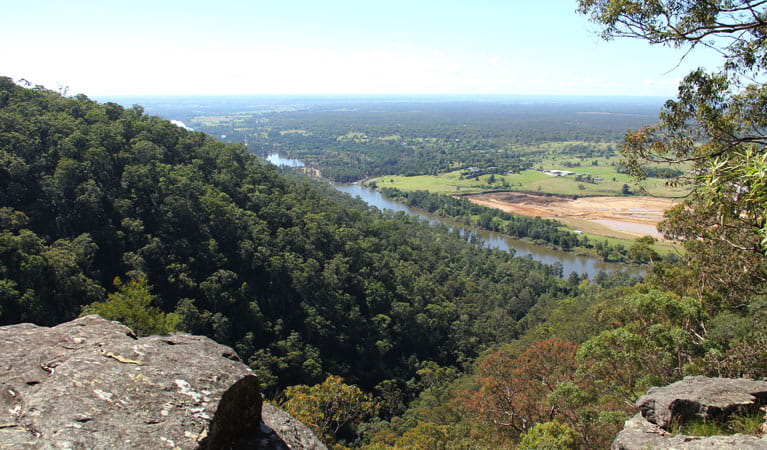Yellomundee Regional Park
Overview
Located near the Blue Mountains, Yellomundee Regional Park boasts great mountain biking trails and scenic lookouts. The park also offers trails and tracks for dog walking and horse riding in certain areas.
Read more about Yellomundee Regional Park
Discover a unique bush experience just minutes from suburbia at Yellomundee Regional Park. The park is positioned on the eastern escarpment of the Blue Mountains, northwest of Penrith in western Sydney.
Visit to see why it’s such a haven for mountain bikers, bushwalkers, horse-riders and dog-walkers. Picnic amongst unspoilt nature while enjoying sweeping views from the park’s lookouts. Or why not volunteer to help with bush regeneration – your opportunity to make a valuable contribution to protecting this special place. There are also great places to canoe along the Nepean River.
A visit to Yellomundee Regional Park gives you the opportunity to explore large areas of native bushland, significant plant communities, and important cultural and historic sites. It's a great family day out.
Local alerts
For the latest updates on fires, closures and other alerts in this area, see https://www.nationalparks.nsw.gov.au/visit-a-park/parks/yellomundee-regional-park/local-alerts
Map
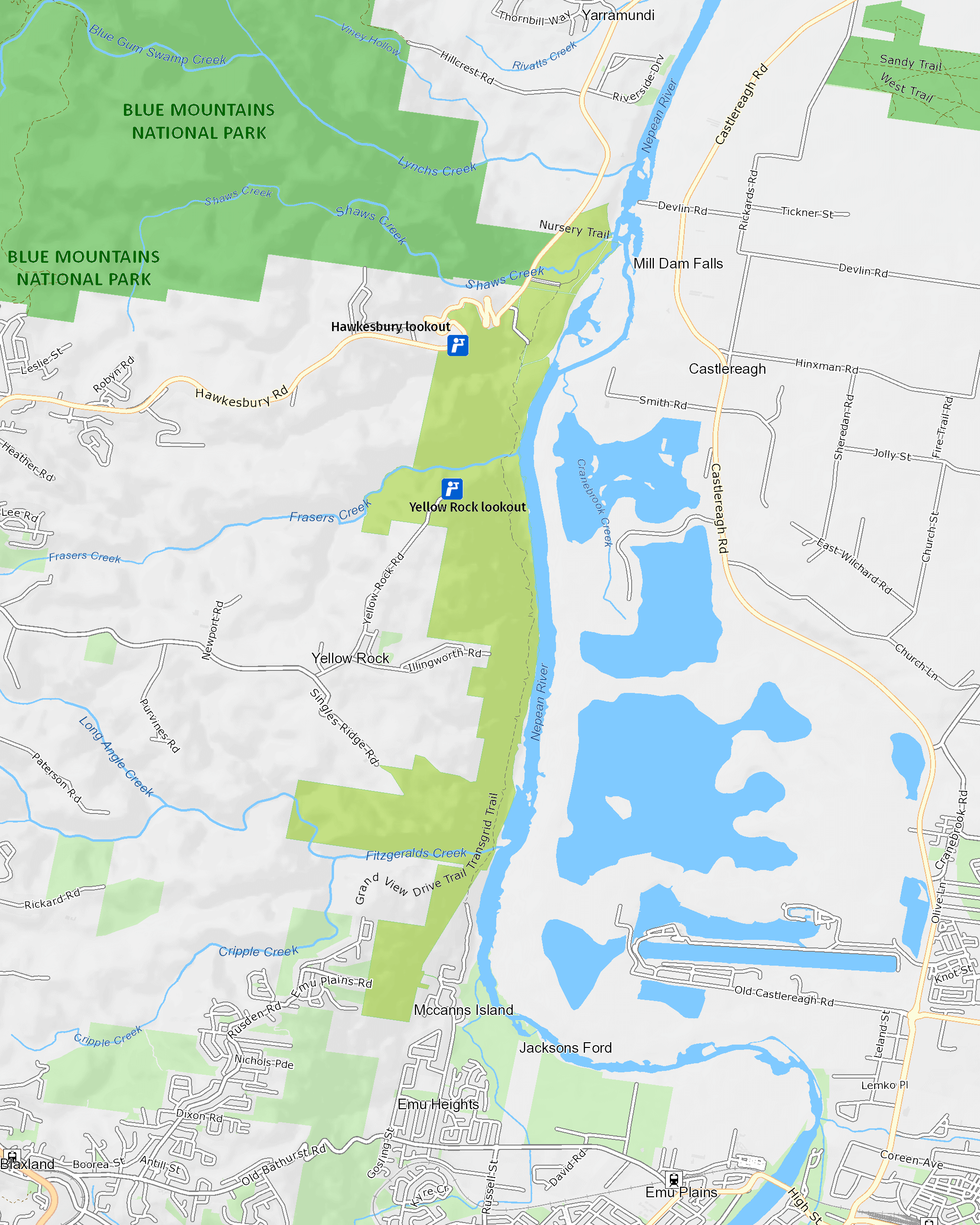
Map legend

Contact
- in the Sydney and surrounds region
Yellomundee Regional Park is always open but may have to close at times due to poor weather or fire danger
-
-
Glenbrook office
02 4632 4500 Infoline
Contact hours: Entry station is only open on weekends, public holidays and school holidays. - 68 Bruce Road, Glenbrook NSW 2773
-
Email: npws.hawkesburynattai@environment.nsw.gov.au
-
Glenbrook office
Visitor info
All the practical information you need to know about Yellomundee Regional Park.
Getting there and parking
Get driving directions
From Emu Plains, exit the Great Western Highway at Hawkesbury Road.
For Hawkesbury lookout, continue for approximately 10km along Hawkesbury Road, then turn right into the carpark.
For Yellow Rock lookout, turn right from Hawkesbury Road into Singles Ridge Road. Turn left into Yellow Rock Road and follow to its end.
Parking
- Hawkesbury lookout See on map
- Yellow Rock lookout See on map
By bike
Check out the Bicycle information for NSW website for more information.
By public transport
For information about public transport options, visit the NSW transport info website
Best times to visit
There are lots of great things waiting for you in Yellomundee Regional Park. Here are some of the highlights.
Please note: Dogs on a lead are permitted at only at Yellow Rock and Hawkesbury lookouts, on the Coreena and Burrawang bridle trails and on the Transgrid management trail along the Nepean River. Horse riding is also permitted only along these same trails.
Autumn
Autumn and Winter Catch some winter sun relaxing on the grassy areas in the park.
Spring
Head to the trails for a bike or horse ride. Enjoy a hot cuppa while taking in magnificent views from one of the park's lookouts.
Summer
Take a trail by bike or horse and enjoy the spectacular views from one of the park's lookouts.
Facilities
Toilets are also available at Shaw Creek shelter in the Shaws Creek area.
Toilets
Picnic tables
Picnic tables are also available at Shaws Creek shelter in the Shaws Creek area.
Maps and downloads
Permitted
Fishing
A current NSW recreational fishing licence is required when fishing in all waters.
Fishing along the Nepean River is accessible via the Shaws Creek entry.
Horses
Horse riding is permitted only along the Coreena-Burrawang trail and the Transgrid management road along the Nepean River.
Pets
You can walk your dog on-lead at this location. See other regional parks in NSW that have dog walking areas.
Dogs are permitted only at Yellow Rock and Hawkesbury lookouts, on the Coreena and Burrawang bridle trails and on the Transgrid management trail along the Nepean River.
You will need to keep them on a leash at all times and remember to pick up after them.
Prohibited
Horses
Horses are not permitted in the Shaws Creek area of the park.
Pets
Dogs are not permitted in the Shaws Creek area of the park.
Smoking
NSW national parks are no smoking areas.
Nearby towns
Springwood (11 km)
The Sassafras Gully Loop is one of a number of excellent walks in Springwood. The trail takes you from Springwood Station and past wonderful rock features, dense bushland and waterfalls. It's a nice cool walk in the shade and you're never too far from water.
Penrith (26 km)
Summer is an ideal time to visit Penrith - one of Sydney's best inland aquatic playgrounds. Have fun riding the rapids at Penrith Whitewater Stadium,, visit Sydney International Regatta Centre, paddle on Nepean Gorge in a canoe or relax with a picnic by the Nepean River.
Katoomba (41 km)
Katoomba is at the heart of most of the stunning natural attractions that make up the Blue Mountains National Park. You can admire deep valleys, sandstone plateaus, waterfalls and native animals from the many walking trails and lookouts near Katoomba.
Learn more
Yellomundee Regional Park is a special place. Here are just some of the reasons why:
Aboriginal culture
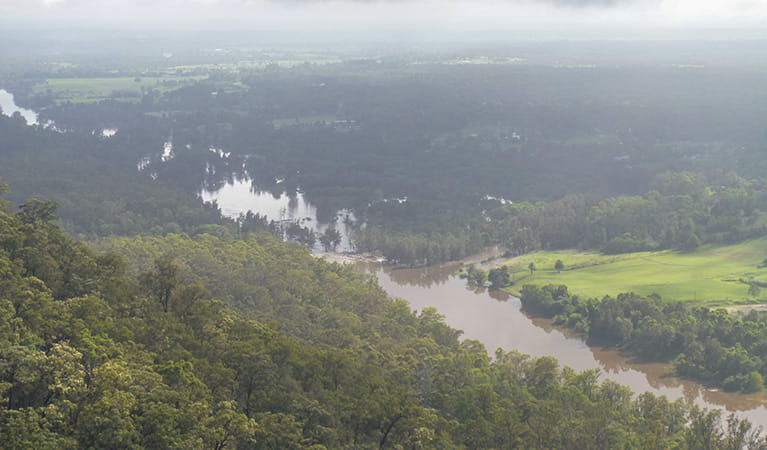
Yellomundee Regional Park lies within the traditional territory of the Boorooberongal clan of the Darug people. The park protects special Aboriginal sites such as Shaws Creek ‘Aboriginal Place’ at the northern end of the park, a place of special significance to Aboriginal culture; demonstrating their connection to this ancient landscape. The park continues to be an important place for Aboriginal people today, with an Aboriginal Landcare group involved in volunteer work to care for this Country.
Natural beauty
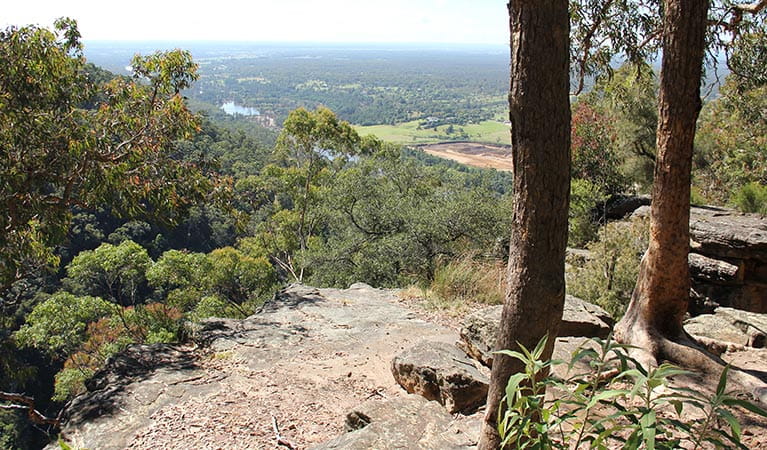
When you visit the park, you’ll find large sprawls of beautiful natural bushland, along with important pockets of alluvial and riverine plant communities. When bushwalking around Yellomundee Regional Park, be sure to take a moment to soak up the protected bushland area along Blue Mountains escarpment. The park protects endangered ecological communities such as shale and sandstone transition forests, Sydney coastal river-flat forest, Cooks River and Castlereagh ironbark forests, as well as ironbark open-forest. Yellomundee also connects the natural beauty of bushland from Nepean River to Blue Mountains National Park.
- Hawkesbury lookout Ideally located on the drive between the Hawkesbury region and the Blue Mountains, Hawkesbury Lookout offers beautiful scenic views and is a great picnic spot.
- Yellow Rock lookout Yellow Rock lookout in Yellomundee Regional Park offers incredible views and a peaceful haven where you can enjoy a picnic, go for a short bushwalk or just take some time out with family and friends.
Recreation ready
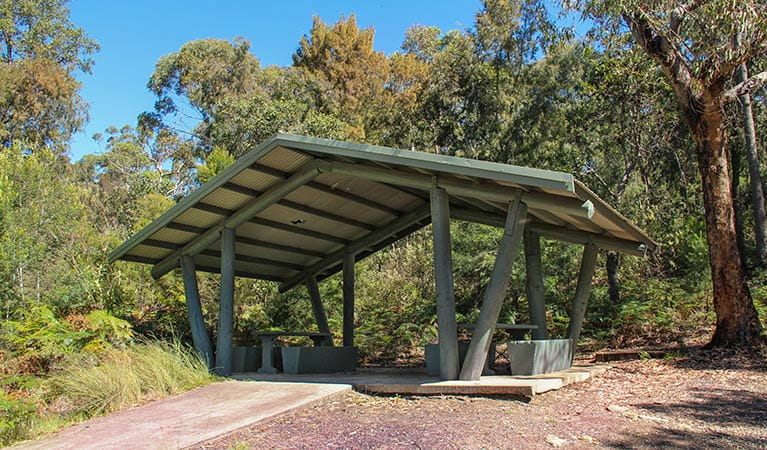
Yellomundee Regional Park is a popular spot with mountain bikers, with competitive clubs regularly using the area. The Western Sydney mountain Bike Club also undertake volunteer work in the park. The area south of Shaws Farm offers trails for varying technical abilities, including some fantastic single trail rides. Horse riding and dog walking are welcomed in Yellomundee, so bring your pet along. Yellomundee sits on the first part of the escarpment between the flat Sydney basin and lofty Blue Mountains; making for a sweeping vista. Visit its scenic lookouts to be rewarded with views over the Nepean River and western Sydney. Both Yellow Rock and Hawkesbury lookouts feature picnicking facilities and ample space to enjoy the scenery.
- Hawkesbury lookout Ideally located on the drive between the Hawkesbury region and the Blue Mountains, Hawkesbury Lookout offers beautiful scenic views and is a great picnic spot.
- Yellow Rock lookout Yellow Rock lookout in Yellomundee Regional Park offers incredible views and a peaceful haven where you can enjoy a picnic, go for a short bushwalk or just take some time out with family and friends.
Plants and animals protected in this park
Animals
-
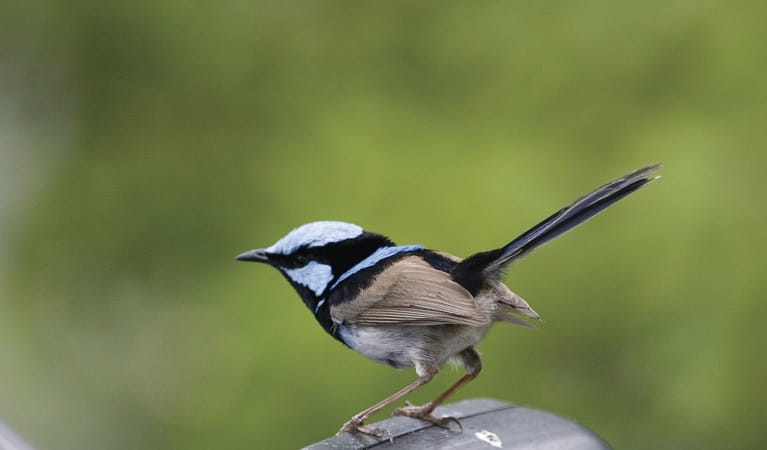
Superb fairy wren (Malurus cyaneus)
The striking blue and black plumage of the adult male superb fairy wren makes for colourful bird watching across south-eastern Australia. The sociable superb fairy wrens, or blue wrens, are Australian birds living in groups consisting of a dominant male, mouse-brown female ‘jenny wrens’ and several tawny-brown juveniles.
-
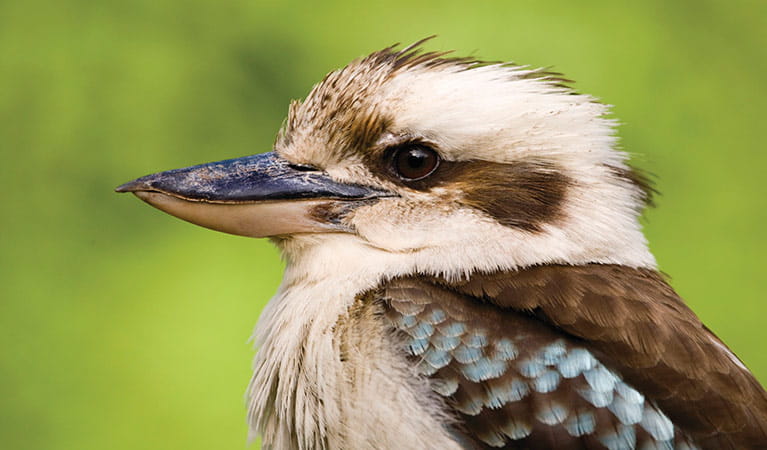
Kookaburra (Dacelo novaeguineae)
Of the 2 species of kookaburra found in Australia, the laughing kookaburra is the best-known and the largest of the native kingfishers. With its distinctive riotous call, the laughing kookaburra is commonly heard in open woodlands and forests throughout NSW national parks, making these ideal spots for bird watching.
Environments in this park
Education resources (1)
What we're doing
Yellomundee Regional Park has management strategies in place to protect and conserve the values of this park. Visit the OEH website for detailed park and fire management documents. Here is just some of the work we’re doing to conserve these values:
Understanding landscapes and geology
Yellomundee Regional Park values the protection and conservation of its landscapes and native vegetation. NPWS employs a range of ongoing initiatives, designed to minimise negative effects on the park’s delicate features and scenic values. Monitoring and rehabilitation, where required, of significant areas are ongoing in this park. NPWS liaises with park neighbours and authorities to avoid adverse impacts.
Managing weeds, pest animals and other threats
Pests and weeds have a significant impact to the ecosystems within Yellomundee Regional Park. NPWS carries out risk assesments for new and emerging weeds to protect biodiversity in this park.
Developing visitor facilities and experiences
NPWS is dedicated to ensuring visitors have positive experiences in NSW national parks, and recognises that visitor facilities and experiences need to be both enjoyable and easily accessed. Efforts to enhance and maintain visitor facilities in Yellomundee Regional Park are ongoing.
Conserving our Aboriginal culture
NPWS manages the Aboriginal heritage of Yellomundee Regional Park in consultation with local Aboriginal community organisations. Together, they work to build community connection with Country. Training programs are in operation, and the park’s Aboriginal heritage and culture is promoted through educational and interpretive programs. All significant sites such as Shaws Creek ‘Aboriginal Place’ at the northern end of the park are protected and maintained, and surveying and cultural assessment is ongoing.
Managing fire
NSW is one of the most bushfire prone areas in the world as a result of our climate, weather systems, vegetation and the rugged terrain. NPWS is committed to maintaining natural and cultural heritage values and minimising the likelihood and impact of bushfires via a strategic program of fire research, fire planning, hazard reduction, highly trained rapid response firefighting crews and community alerts.

